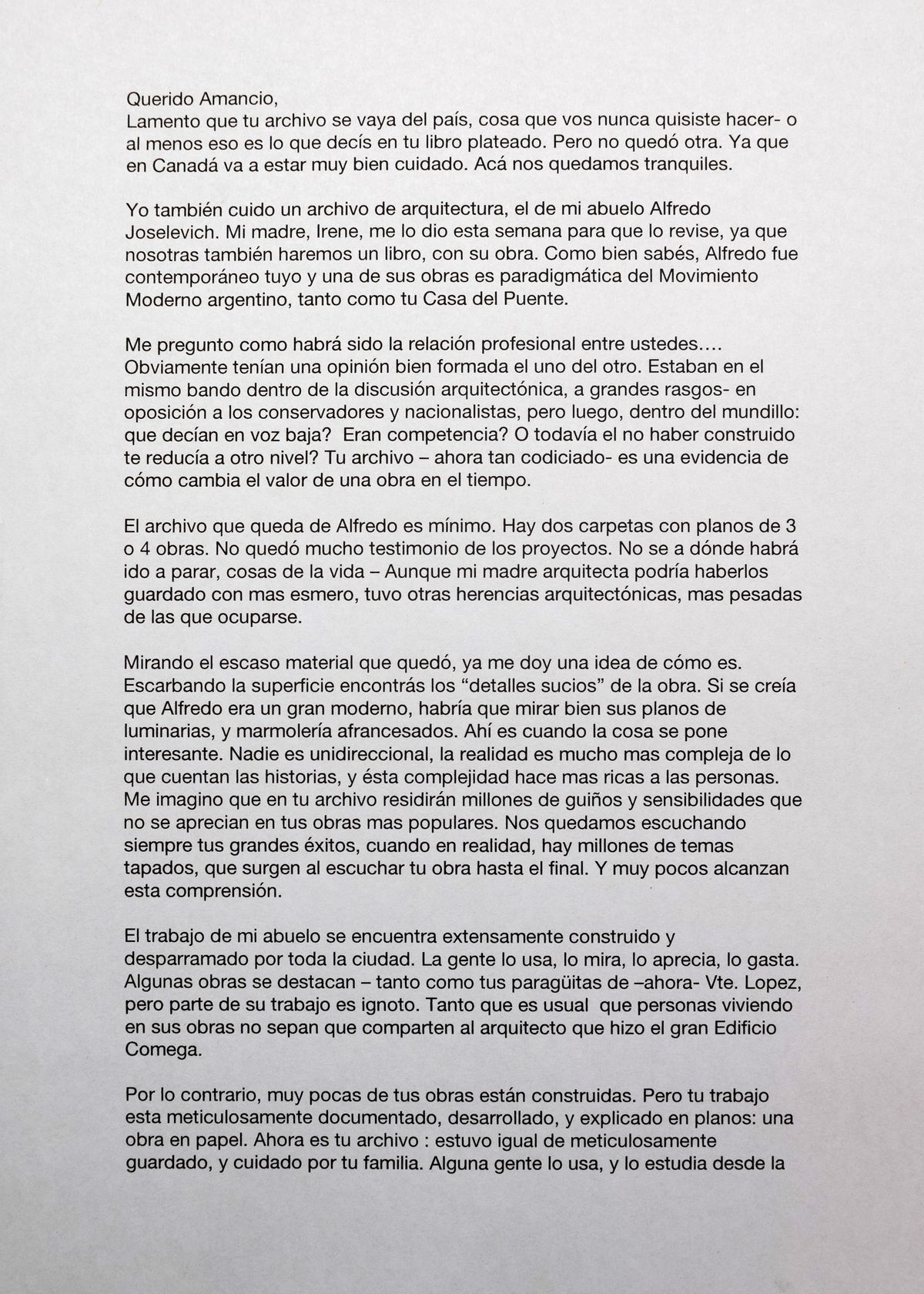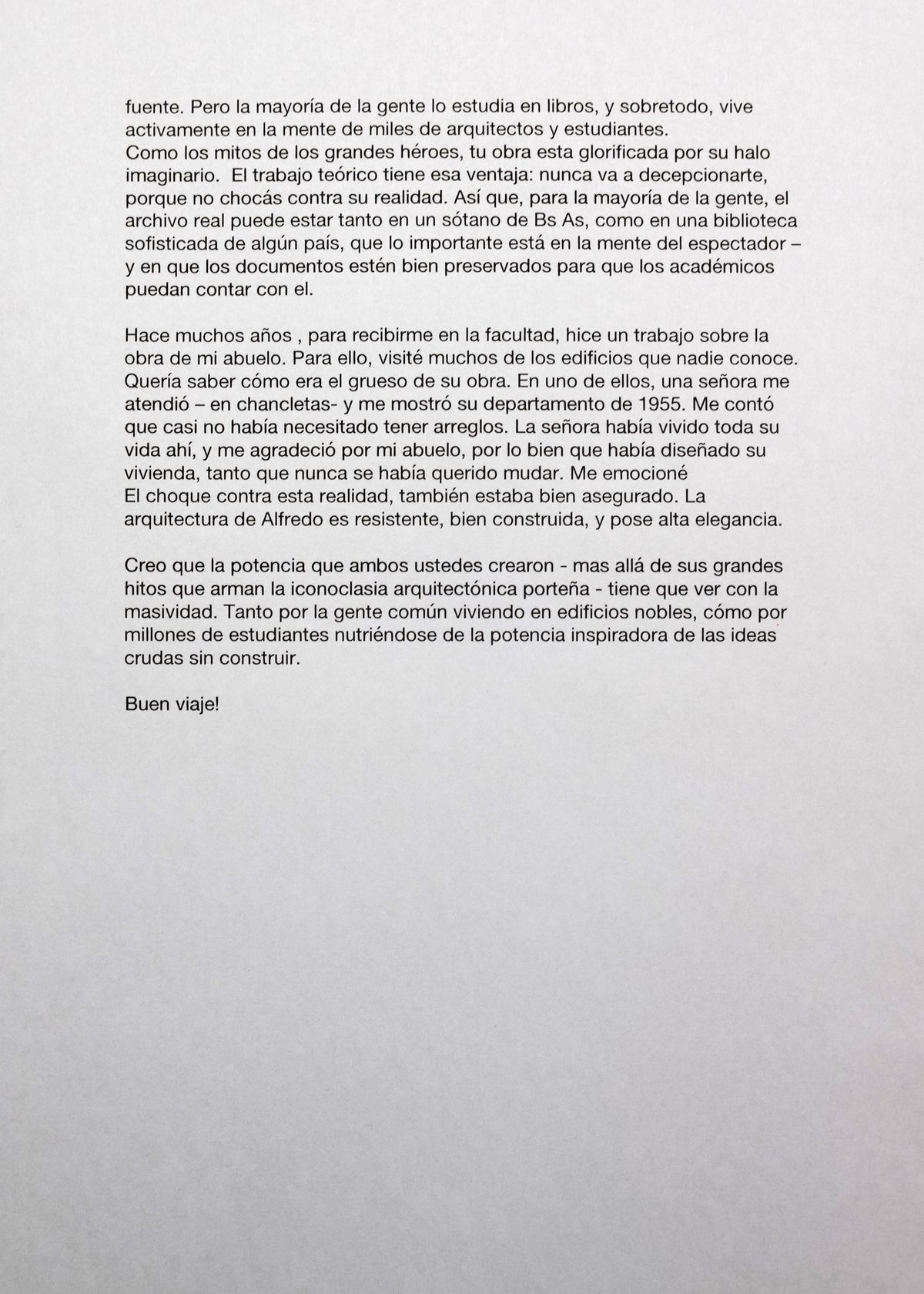I’m sorry that your archive is leaving the country; it’s something you never wanted to happen—at least, that’s what you said in your silver book. But there was nothing for it here. In Canada, it will be very well cared for. In that we have every faith.
I look after an architecture archive, that of my grandfather, Alfredo Joselevich. My mother, Irene, gave it to me this week to revise, as we’re also going to make a book of his work. Of course, Alfredo was a contemporary of yours, and one of his works is emblematic of the Argentine Modern Movement, like your Bridge House.
I wonder what the professional relation between the two of you was like…. You each must have carried a well-formed opinion of the other. You were on the same side of the architecture debate, broadly speaking, opposing the conservatives and the nationalists. But then, in architect’s circles, what did you really think of each other? Did you compete? Or did the fact that you had no built work yet place you on a different level? Your archive, now so coveted, shows how the value of a body of work changes over time.
The archive that remains of Alfredo’s work is minimal. There are two folders with plans of three or four works. Little evidence remains of the projects. I don’t know where it all ended up; it’s one of life’s mysteries…. My mother, also an architect, might have kept them more carefully, but she also had other, weightier architecture legacies to look after.
Looking at the scant materials that remain, I can form an idea of the work. If you scratch the surface, you find “rough details.” People consider Alfredo a great modern architect, but they should also take a good look at his plans for lighting fixtures and French-style marble work. That’s where things get interesting. No one is one-directional—reality is much more complex than history would have us believe, and this complexity enriches people.
I imagine that your archive is full of millions of references and sensibilities that go unappreciated compared to your more popular works. We always end up listening to your greatest hits when there are millions of songs hidden beneath that emerge only when we fully hear your work to the end. And very few people gain this understanding.
My grandfather’s work is widely built and scattered all over the city. People live in it, look at it, appreciate it, and use it. Some works stand out as much as your umbrellas in what is now Vicente Lopez, but part of his work is unknown. So much so that it is quite common for people living in his works to be unaware that they share the architect who designed the great Comega Building.
Conversely, very few of your works are built. But your work is meticulously documented, developed, and explained in plans: it is a body of work on paper. Now it is your archive, and it was just as meticulously kept as it was cared for by your family. Some people use the archive, to study the work at its source. But any more people study it through books, and, most of all, your work lives actively in the minds of thousands of architects and students.
Like in the myths about great heroes, your work is glorified by an invisible halo. Theoretical work has that advantage: it will never disappoint because we do not come up against its reality. So, for most people, the physical archive could just as well be in a basement in Buenos Aires as in a sophisticated library in another country, because what is important remains in the mind of the beholder—and that the documents be well preserved so that academics can continue to refer to it.
Many years ago, to enter the faculty, I did a project about my grandfather’s work. To do so, I visited several of his buildings that no one knew. I wanted to become acquainted with the bulk of his work. In one case, a woman welcomed me—in flip-flops—and showed me her apartment since 1955. She told me that she had not needed to make practically any changes. The woman had lived there her entire life and she thanked me for my grandfather, for his having designed her home so well that she had never wanted to move. I was deeply moved.
I had felt well-insured to come up against this reality. Alfredo’s architecture is strong, well built, and very elegant.
I think that the potency that the two of you created—beyond the milestones that populate the architectural iconoclasm of Buenos Aires—has to do with massiveness. With ordinary people living in noble buildings, and with millions of students drawing on the inspiring potency of raw, unbuilt ideas.
Bon voyage!
Ana
Buenos Aires, 11 March 2020

